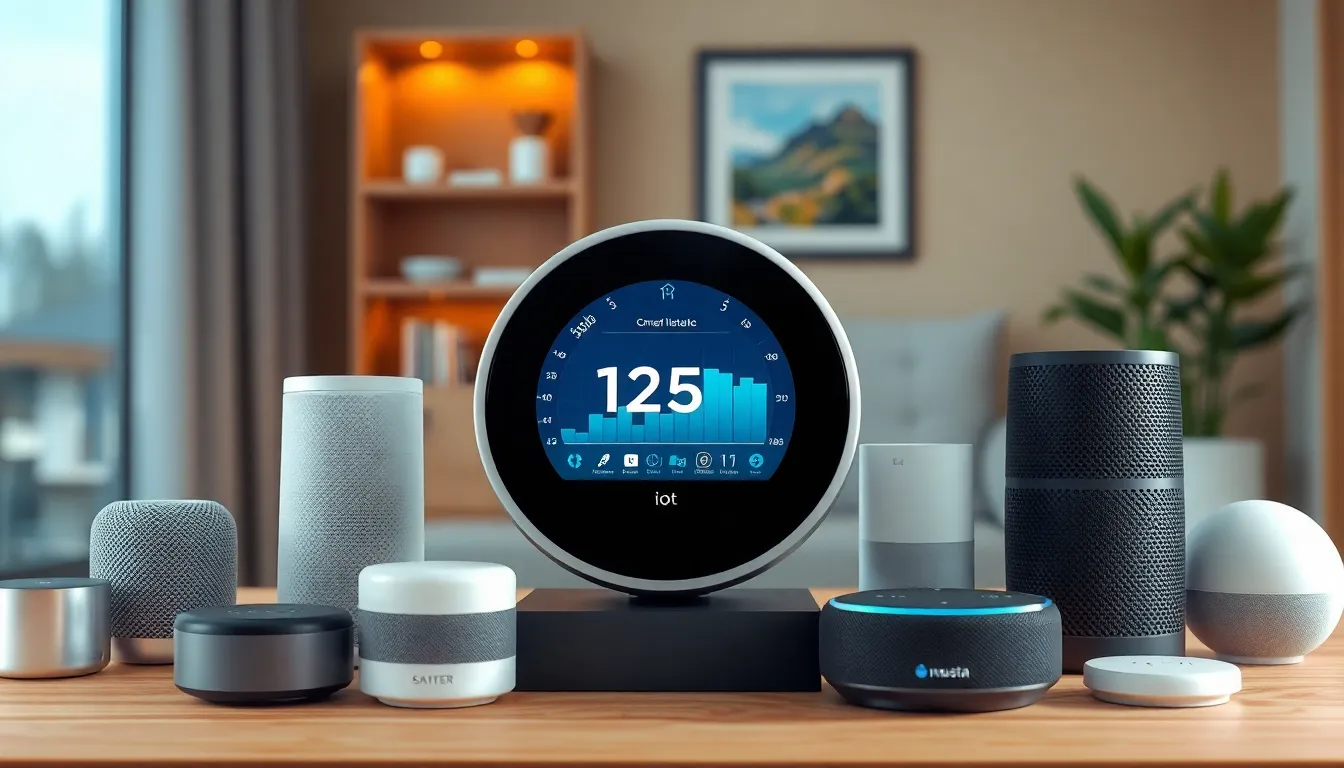In a world where your toaster might just be smarter than you, the fusion of artificial intelligence and the Internet of Things (IoT) is revolutionizing everyday life. Imagine a home that anticipates your needs, turning on the coffee machine before your feet even hit the floor. Sounds like magic? It’s just AI and IoT working together to make life a little easier and a lot more interesting.
As these technologies intertwine, they’re not just creating smart devices; they’re crafting a seamless ecosystem that communicates, learns, and adapts. From smart cities to health monitoring, the possibilities are endless—and they’re growing faster than your Wi-Fi signal can handle. Dive into this exciting realm where innovation meets convenience, and discover how AI and IoT are transforming the way we live, work, and play.
Table of Contents
ToggleUnderstanding Artificial Intelligence and IoT
Artificial intelligence (AI) and the Internet of Things (IoT) represent pivotal advancements that revolutionize everyday experiences. Both technologies enhance interconnectedness and intelligence in devices.
Definition of Artificial Intelligence
Artificial intelligence refers to computer systems that perform tasks typically requiring human intelligence. These tasks include problem-solving, learning, and decision-making. Machine learning and natural language processing constitute key components of AI. Algorithms enable machines to analyze data patterns, leading to predictive capabilities. In various sectors, AI improves efficiency and augments human decision-making. Examples include virtual assistants and predictive maintenance tools across industries.
Definition of IoT
The Internet of Things describes a network of interconnected devices that communicate and exchange data. Sensors embedded in everyday objects gather information and transmit it through the internet. Smart appliances, wearables, and vehicles exemplify the application of IoT. Each connected device enhances user experience by optimizing functionality. IoT creates opportunities for improved resource management and real-time monitoring. Data collected helps users make informed decisions, contributing to efficiency and convenience in daily life.
The Relationship Between Artificial Intelligence and IoT

Artificial intelligence and the Internet of Things work together to create smarter solutions. They enhance efficiency in various applications, revolutionizing how devices interact and respond.
How AI Enhances IoT Functionality
AI significantly improves IoT functionality by enabling devices to learn and adapt. Intelligent algorithms analyze user preferences, allowing them to tailor experiences and automate tasks. For example, a smart thermostat can learn a user’s schedule and adjust the temperature accordingly, saving energy and enhancing comfort. The continuous feedback loop between AI and connected devices enhances overall performance and reliability. Improved decision-making capabilities result from this fusion, creating a seamless and responsive ecosystem.
IoT Data and AI Analytics
IoT generates vast amounts of data, which AI analyzes to extract valuable insights. Sensors collect real-time information about user behavior, environmental conditions, and system performance. AI processes this data, identifying patterns and trends that humans might overlook. Businesses leverage these insights to optimize operations, enhance customer experiences, and anticipate maintenance needs. Data-driven decisions become more precise and informed. Integrating AI analytics with IoT data ensures that organizations remain agile and responsive to changes.
Applications of Artificial Intelligence and IoT
Artificial intelligence and the Internet of Things create numerous applications that redefine various sectors. These technologies enhance everyday experiences, leading to groundbreaking innovations.
Smart Homes
Smart homes rely on AI and IoT to improve convenience and energy efficiency. Devices like smart thermostats automatically adjust to user preferences, ensuring optimal comfort. Home security systems monitor activity, providing real-time alerts and remote access control. AI analyzes energy consumption patterns, helping homeowners reduce waste. Lighting systems often adapt to natural light levels, enhancing ambiance while conserving energy. Voice-activated assistants streamline daily tasks by integrating with multiple devices, making interaction intuitive and user-friendly. Together, these elements create a seamless living environment that embodies efficiency and comfort.
Industrial Automation
Industrial automation benefits significantly from AI and IoT integration. Factories deploy smart sensors to monitor equipment performance and identify potential issues before they escalate. Machine learning algorithms analyze production data, optimizing processes and reducing downtime. Robotics equipped with AI adapt to changes in production lines, allowing for flexible manufacturing. Predictive maintenance minimizes machine failures, enhancing productivity and resource management. Supply chain optimization happens through real-time data analysis, enabling better inventory control and demand forecasting. These advancements translate into increased operational efficiency and reduced costs across various industries.
Challenges in Integrating Artificial Intelligence and IoT
Integrating AI and IoT brings straightforward yet significant challenges. Organizations must navigate various obstacles to realize the full potential of these technologies.
Security Concerns
Security remains a critical issue in the integration of AI and IoT. The interconnected nature of smart devices exposes them to cyber threats. Breaches can occur through unsecured networks or vulnerabilities in device software. Hackers may exploit these weaknesses, gaining unauthorized access to sensitive data. Manufacturers must implement robust security protocols to safeguard devices. Regular software updates are essential to patch known vulnerabilities. Organizations should also consider end-to-end encryption to ensure data integrity during transmission. Addressing these security concerns proactively minimizes potential risks and builds consumer trust.
Data Privacy Issues
Data privacy poses another challenge as AI and IoT generate and utilize vast amounts of sensitive information. Personal user data collected by smart devices can lead to misuse if not adequately protected. Regulations such as GDPR and CCPA outline obligations for data protection, but compliance can be complex. Organizations face the risk of significant penalties if they fail to adhere to privacy requirements. Transparency in data handling practices helps demystify how user data is collected, stored, and used. Establishing user consent mechanisms empowers individuals to control their personal information. Prioritizing data privacy fosters customer confidence in adopting AI and IoT solutions.
Future Trends in Artificial Intelligence and IoT
Artificial intelligence and the Internet of Things continue to evolve, shaping the future of technology. Emerging trends signal significant shifts in how these technologies interact and impact everyday life.
Emerging Technologies
Edge computing enhances the performance of AI and IoT by processing data closer to the source. This reduces latency, allowing real-time analysis and quicker responses. Integration of 5G technology strengthens connectivity between devices, promoting seamless communication. Advanced machine learning algorithms enable predictive analytics, which anticipate user needs more effectively. Furthermore, blockchain technology ensures secure data sharing across IoT devices, addressing security concerns. Augmented reality applications leverage AI to enrich user experiences, merging digital data with the physical world. Overall, these emerging technologies create a more interconnected and responsive ecosystem.
Potential Market Growth
The AI and IoT market is poised for substantial growth, with projections estimating a compound annual growth rate (CAGR) of 26.9% from 2022 to 2030. This indicates a surge from $328.7 billion in 2021 to over $1.6 trillion by 2030. Smart home technology remains a significant driver, as consumers increasingly adopt connected devices. Industries such as healthcare and manufacturing also embrace these innovations, enhancing efficiency and operational effectiveness. Key players are investing heavily in research and development to unlock the potential of AI and IoT. This commitment fuels competition and accelerates technological advancements, further propelling market expansion.
The synergy between artificial intelligence and the Internet of Things is undeniably shaping the future. As smart devices become increasingly integrated into daily life they not only enhance convenience but also drive efficiency across various sectors. The potential for innovation remains vast with emerging technologies poised to further transform how individuals and organizations operate.
However challenges like security and data privacy must be addressed to ensure user trust and safety. By prioritizing robust security measures and transparent data practices businesses can create an environment where AI and IoT thrive. As these technologies continue to evolve their impact will only grow making it essential for everyone to stay informed and engaged in this exciting landscape.



